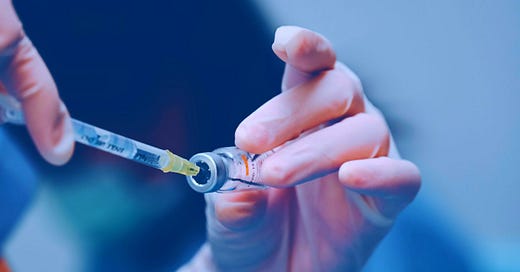Study of 99 Million COVID-Vaccinated Confirms Increased Risk for Cardiovascular and Neurological Disorders: Journal 'Vaccine'
Vaccinated at higher risk of myocarditis, pericarditis, Guillain-Barré syndrome, cerebral venous sinus thrombosis, and acute disseminated encephalomyelitis.
A new study published this month in Vaccine analyzed an unprecedented 99,068,901 individuals vaccinated for COVID-19.
Follow Jon Fleetwood on Instagram @realjonfleetwood / Twitter @JonMFleetwood
The study evaluated the risk of injury, or adverse events of special interest (AESI), following COVID vaccination from 10 sites across eight countries.
This was accomplished through the Global COVID Vaccine Safety (GCoVS) Project that was established in 2021 under the multinational Global Vaccine Data Network™ (GVDN®).
Vaccine injuries occurring only up to 42 days following vaccination with Pfizer and Moderna’s mRNA jabs (BNT162b2 and mRNA-1273) and AstraZeneca’s adenovirus-vector (ChAdOx1) vaccine were included in the primary analysis.
Researchers found higher-than-expected ratios for Guillain-Barré syndrome and cerebral venous sinus thrombosis after the first dose of the AstraZeneca vaccine.
They also found a higher-than-expected ratio for acute disseminated encephalomyelitis after the first dose of the Moderna vaccine.
The risk of myocarditis and pericarditis was increased after any of the vaccines.
Guillain-Barré syndrome (GBS): a rare autoimmune disorder that weakens nerves, leading to tingling, weakness, and sometimes paralysis.
Cerebral venous sinus thrombosis: an uncommon condition where blood clots form in the brain's venous sinuses, impeding blood flow out of the brain. This blockage can cause blood vessel damage and leakage, increasing the risk of hemorrhage and stroke.
Disseminated encephalomyelitis: a rare autoimmune disease characterized by widespread inflammation in the central nervous system
Myocarditis: a serious condition characterized by inflammation in the myocardium, the middle muscular layer of the heart wall.
Pericarditis: inflammation of the pericardium, the thin, two-layered, fluid-filled sac that covers the outer surface of the heart.
Follow Jon Fleetwood on Instagram @realjonfleetwood / Twitter @JonMFleetwood
After receiving the first dose of the AstraZeneca vaccine, individuals are approximately 2.49 times more likely to develop Guillain-Barré syndrome compared to those who did not take the vaccine, according to the study.
Individuals who received the AstraZeneca vaccine are also approximately 3.23 times more likely to develop cerebral venous sinus thrombosis than those who did not.
Recipients of Moderna’s vaccine are approximately 3.78 times more likely to develop acute disseminated encephalomyelitis compared to those who did not.
Individuals who received first and second doses of Moderna’s vaccine were approximately 3.48 and 6.10 times more likely to develop myocarditis compared to those who did not.
Individuals who received first and fourth doses of Moderna’s shot were approximately 1.74 and 2.64 times more likely to develop pericarditis compared to those who did not.
Individuals who received a third dose of AstraZeneca’s vaccine were approximately 6.91 times more likely to develop pericarditis compared to those who did not.
Follow Jon Fleetwood on Instagram @realjonfleetwood / Twitter @JonMFleetwood
Read the full study below:
The study authors’ affiliations include:
Department of Epidemiology Research, Statens Serum Institut, Copenhagen, Denmark
Department of Statistics, University of Auckland, New Zealand
Global Vaccine Data Network, Global Coordinating Centre, Auckland, New Zealand
National Centre for Immunisation Research and Surveillance, Westmead, New South Wales, Australia
Department of Epidemiology, Ricardo Gutierrez Children Hospital, Buenos Aires University, Argentina
ICES, Toronto, Ontario, Canada
Public Health Ontario, Toronto, Ontario, Canada
Department of Family and Community Medicine, Temerty Faculty of Medicine and the Dalla Lana School of Public Health, University of Toronto, Toronto, Ontario, Canada
The University of Sydney, Australia
British Columbia Centre for Disease Control, Vancouver, British Columbia, Canada
Public Health Scotland, Glasgow, Scotland, United Kingdom
Université Paris-Saclay, UVSQ, Inserm, CESP, High Dimensional Biostatistics for Drug Safety and Genomics, Villejuif, France
Murdoch Children’s Research Institute, Parkville, Victoria, Australia
School of Population and Public Health, University of British Columbia, Vancouver, British Columbia, Canada
Department of Health Security, Finnish Institute for Health and Welfare, Helsinki, Finland
Dalla Lana School of Public Health, University of Toronto, Toronto, Ontario, Canada
Department of Public Welfare, Finnish Institute for Health and Welfare, Helsinki, Finland
Faculty of Social Sciences, Tampere University, Finland
School of Public Health, Peking University, China
Auckland UniServices Limited at University of Auckland, New Zealand
School of Population Health, University of Auckland, New Zealand
University of Melbourne, Parkville, Victoria, Australia
Pharmacovigilance Research Center, Department of Drug Design and Pharmacology, Faculty of Health and Medical Sciences, University of Copenhagen, Copenhagen, Denmark
School of Public Health, SUNY Downstate Health Sciences University, Brooklyn, NY, USA
Follow Jon Fleetwood on Instagram @realjonfleetwood / Twitter @JonMFleetwood





Hello Jon, would you be interested in digging and finding info on the ocular (eye) damage from these shots? my sister (i was upset when I heard) just went and got another and right after had another eye issue, she needs an additional surgery now because of it. I don’t hear any talk or news on this type of damage and it would be good to get that news out as well.
Since the study authors and media are framing the conclusions ,“This multi-country analysis confirmed pre-established safety signals for myocarditis, pericarditis, Guillain-Barré syndrome, and cerebral venous sinus thrombosis. Other potential safety signals that require further investigation were identified”, every single individual who was NOT informed of these “pre-established” risks and suffered injury or potential injury needs to not only sue the government whose health authorities failed to inform them, but also the physicians, medical centers and pharmacists who administered the injections without informing them of these “pre-established” risks. It also opens the door wide open to suits against any employer, school or other entity that mandated the injections.